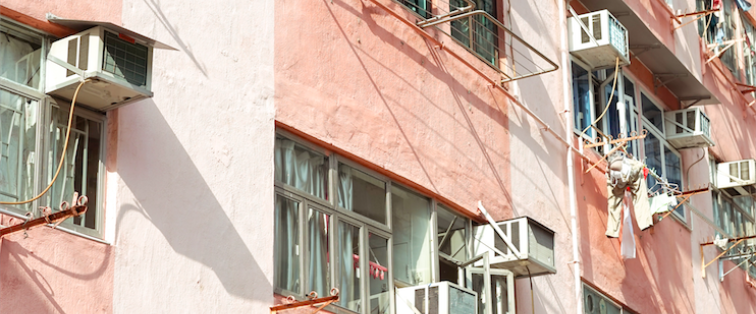Public Housing Goes Smoke-Free Nationwide

Starting yesterday, all public housing properties in the U.S. are required to go completely smoke-free—a move public health advocates are broadly applauding because of the potential this policy change could have on improving intergenerational health outcomes. This action is the result of a U.S. Department of Housing and Urban Development (HUD) rule issued in November 2016 that prohibits the use of all combustible tobacco products—including cigarettes, cigars, pipes and water pipes—in public housing properties. The rule applies to all living units, indoor common areas, administrative offices and outdoor areas within 25 feet of the building. With this widespread reach, HUD is aiming to reduce exposure to secondhand smoke among residents of public housing properties.
According to the U.S. Surgeon General’s 2006 report on the health consequeneces of tobacco smoke exposure, “there is no risk-free level of exposure to secondhand smoke.” Secondhand smoke increases the risk of a variety of health problems in children and adults. Exposure during pregnancy or following birth increases the risk of sudden infant death syndrome (SIDS), and exposure among older children is linked to higher risk of respiratory infections and more frequent/severe asthma attacks. In adults, secondhand smoke increases the risk of heart disease, stroke, cancer and respiratory diseases. Health care providers and researchers are also increasingly recognizing “thirdhand smoke,” smoke residue that sticks to indoor surfaces including carpets, furniture, and walls, as a significant concern. Infants and small children are particularly vulnerable to thirdhand smoke due to spending more time indoors and in close proximity to contaminated surfaces.
As an epidemiologist and health policy researcher, I’m deeply concerned by the intergenerational impacts that tobacco use can have in a family, from a parent’s use directly impacting the health of a child to that same child’s increased likelihood of becoming a smoker in adolescence or later in life. As such, I have studied the effects of laws prohibiting smoking in workplaces, bars and restaurants on smoking rates and related health outcomes. In a study among young to middle-aged U.S. adults, my co-authors and I found that smoke-free laws were associated with lower risk of cardiovascular disease. These findings join a large body of evidence indicating that smoke-free laws reduce secondhand smoke exposure and improve health outcomes for children and adults.
However, families living in public housing remain at higher risk for secondhand smoke exposure than the general population. Even though smoking rates have declined nationwide, adults living below the federal poverty level are more likely to smoke than those with higher incomes. Also, most public housing residents live in multi-unit properties. Secondhand smoke can move between units through walls and ventilation ducts, putting families in multi-unit public housing at risk for elevated levels of exposure.
Many local public housing authorities, including Philadelphia, have already gone smoke-free, but HUD’s rule expands this protection to all remaining authorities in the United States. Prohibiting smoking in public housing has the potential to protect the over two million public housing residents (including more than 750,000 children) from involuntary secondhand smoke exposure. Preliminary research indicates that these policies may reduce secondhand smoke exposure among residents and may encourage smoking residents to quit. However, in order to have a real impact on health, officials will need to adequately enforce smoke-free public housing rules. Researchers have uncovered challenges to enforcement through interviews with residents and staff, such as non-smokers’ reluctance to report their neighbors for violations and smokers feeling unfairly targeted. Given the strong potential for smoke-free public housing to reduce secondhand smoke exposure and improve health, researchers must continue evaluating the enforcement and effects of these laws to determine whether promising early results are sustained.
I also share a concern raised by many public health advocates that the new smoke-free policies may place an additional burden on an already vulnerable population of low-income families. While smokers are not prohibited from living in public housing, they may face penalities if they are unable to avoid smoking in the newly restricted areas including, as a last resort, eviction. For smoke-free public housing policies to be successful and avoid worsening disparities, its critical that residents who want to quit have access to smoking cessation services such as state-based and national telephone quit lines that provide free, evidence-based cessation services. Residents should also receive information on the Affordable Care Act’s requirement that most health insurance plans cover smoking cessation treatments including nicotine replacement therapy, other smoking cessation medications and counseling.
Finally, we must support research into innovative ways to promote smoking cessation. For example, my fellow PolicyLab researcher Dr. Brian Jenssen has developed tools for providing smoking cessation services to parents in pediatric primary care settings and is exploring options to get these services reimbursed through insurance providers. Directing families residing in public housing to these resources must be an important component of policy implementation.
As smoking-related diseases result in nearly half a million deaths every year in the U.S., public policies that aim to reduce smoking and secondhand smoke exposure are vital prevention measures. The new HUD rule has the potential to protect many children in this country from the dangers of secondhand smoke and substantially improve health for thousands of low-income families. Effective enforcement and evaluation will be essential moving forward in order to determine whether the policy is achieving its intended effect.
